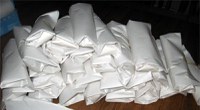Prairie Fare: Freeze in the Heat of Summer
(Click the image below to view a high-resolution image that can be downloaded)
By Julie Garden-Robinson, Food and Nutrition Specialist
NDSU Extension Service
“Is my frozen turkey still safe to eat? I think it has been frozen for two years. I also found a roast at the bottom of my freezer, and I’m not sure how long it has been there. Is that OK to eat?” my caller asked.
“Let me ask you a couple of questions. Was your food solidly frozen the entire time? Did you have any power outages?” I responded.
“The freezer was on all the time,” she replied.
“If the food remained frozen, it is safe to eat indefinitely. However, you probably will see some quality changes that affect the flavor and texture with long storage. If you see areas that are dry or discolored, that could mean that the meat is freezer-burned. That is a quality issue, not a safety issue,” I replied.
“Would you eat it?” she asked.
“I probably would, but I might baste the turkey more often and add a marinade to the roast. Be sure to thaw it in the refrigerator. If it has off-odors after thawing, I probably wouldn’t eat it, though,” I added.
Food storage questions are common for NDSU Extension Service family and consumer sciences agents. No one likes to waste food because that is like throwing money in the trash.
Freezing is a convenient and versatile method of preserving meat, fruits and vegetables and also making your own “convenience foods” at home, but be sure to manage your frozen food inventory.
Consider posting an inventory sheet on the front or top of your freezer and noting when you add or subtract foods from the inventory.
Unlike canning, which “sterilizes” food, freezing does not kill bacteria. It simply stops them from growing. Upon thawing, any bacteria that were present “wake up” and grow if the food is allowed to thaw at room temperature.
Buying meat in bulk and repackaging in recipe-sized portions can stretch your budget at home. In fact, proper freezing is considered an excellent preservation method for maintaining the quality, color and nutrition of foods. Proper packing is of primary importance when freezing because exposure to air can promote flavor and color changes. Be sure to use moisture-proof wrapping paper or freezer bags.
Do you know how to do the butcher wrap, drugstore wrap and the casserole wrap?
To wrap meat securely using the butcher wrap, simply place the food at one corner of the freezer wrap, then fold the food and wrap over two times in the direction of the opposite corner. Fold the ends up and push the air out as you fold. With ends tucked, continue to fold food. Finally, pull the end tight and seal with freezer tape. Label the package with the contents and date you froze it.
See the “Food Freezing Guide” at http://www.ag.ndsu.edu/pubs/yf/foods/fn403.pdf for directions and illustrations for other wrapping methods.
If you decide to freeze your own casseroles and desserts, remember that foods such as celery and lettuce do not freeze well. Custards and sauces may separate during freezing. Be sure to slightly undercook pasta-based dishes such as lasagna prior to freezing to avoid mushiness.
Here’s a recipe that can make three frozen meals for a family of four. Serve with rice or pasta, a side salad, fruit and milk for a balanced meal.
Freezer Meal Barbecue Meatballs
2 pounds extra lean (90 percent) ground beef
2 large eggs
2 c. quick oatmeal
1 c. minced onion
1 c. milk
1 tsp. black pepper
Mix and make 72 walnut-sized balls. (Note: Making them small allows the sauce to penetrate during the baking process.) Place in a single layer in a large baking pan with sides. Sauce:
3 c. ketchup
2 c. brown sugar
3 Tbsp. liquid smoke
Mix sauce over low heat and pour half of mixture or less over meatballs. Bake at 350 F for one hour or until they reach an internal temperature of 160 F. Allow the meatballs to cool, then place them in freezer bags in meal-sized amounts (about six meatballs per serving). For example, to serve a family of four, place 24 meatballs in a freezer bag. Add sauce to each bag, then freeze flat. Thaw in the refrigerator, then reheat in a microwave oven, oven or sauce pan, adding a little water if necessary. Serve over rice or pasta.
Makes 12 servings (six meatballs per serving). Each serving has 360 calories, 9 grams (g) of fat, 50 g of carbohydrate, 20 g of protein and 750 milligrams of sodium.
(Julie Garden-Robinson, Ph.D., R.D., L.R.D., is a North Dakota State University Extension Service food and nutrition specialist and professor in the Department of Health, Nutrition and Exercise Sciences.)
NDSU Agriculture Communication – June 12, 2014
| Source: | Julie Garden-Robinson, (701) 231-7187, julie.garden-robinson@ndsu.edu |
|---|---|
| Editor: | Rich Mattern, (701) 231-6136, richard.mattern@ndsu.edu |


